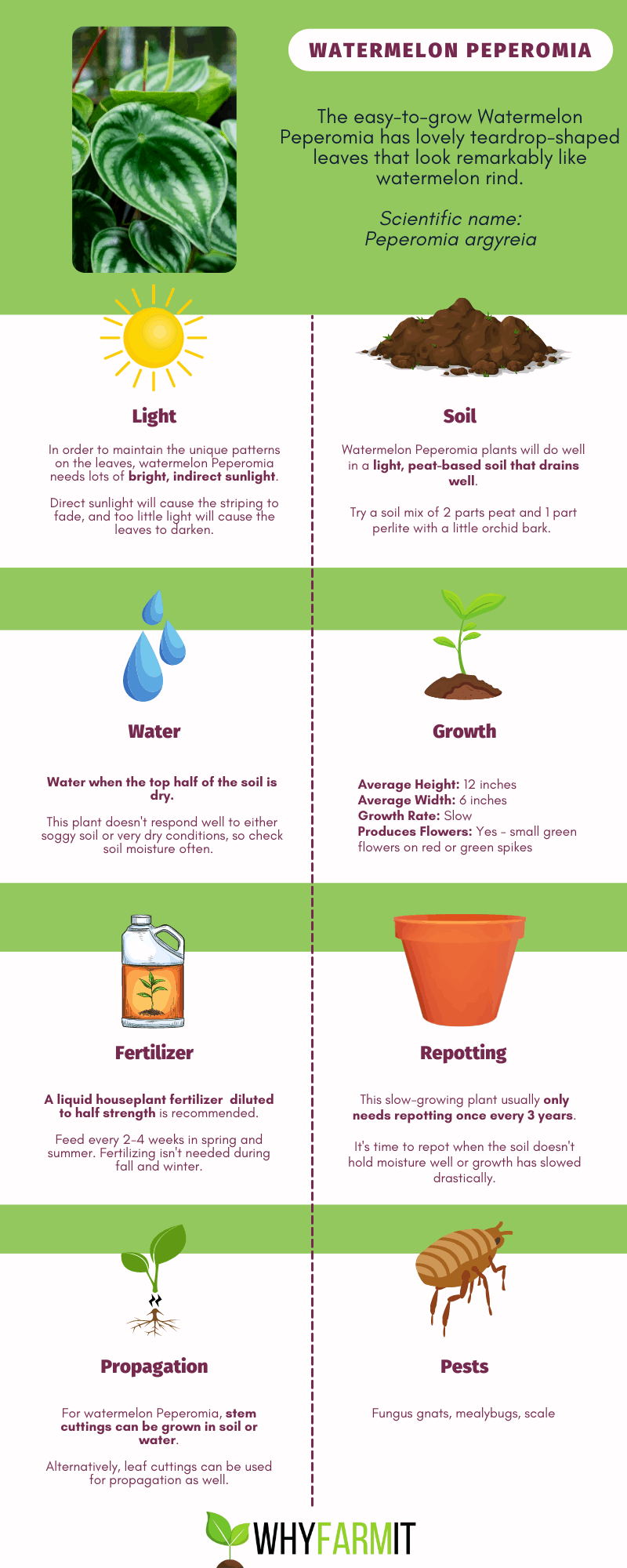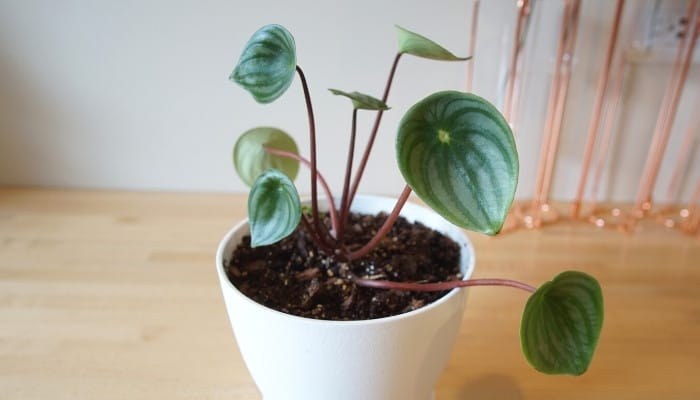In recent times, Watermelon Peperomia, a small and distinctive houseplant, has seen a surge in popularity.
This topical perennial has teardrop-shaped leaves with a pattern similar to a watermelon rind. It is considered a small house plant and looks great on a desk or bedside table.
How do you care for watermelon peperomia? Watermelon Peperomia will thrive when planted in a peat-based soil with good drainage and placed in bright, indirect light. Water only when the top half of soil is dry, use a diluted liquid fertilizer every few weeks in the spring and summer, and maintain temperatures between 65 and 75℉.
Caring for Watermelon Peperomia: Basic Guidelines
One look at watermelon Peperomia and it is clear why it has become a favorite houseplant.
With great care, this plant will be full of distinct leaves with a shimmering silver pattern. It is a beautiful addition to any room.
Complete Care Guide for Watermelon Peperomia
Watermelon Peperomia is native to the rain forests of South America. It is used to bright, filtered light coming through the canopy above.
These conditions can be replicated at home to produce a healthy, full plant.
Watermelon Peperomia at a Glance
- Plant Type: Tropical
- Scientific Name: Peperomia argyreia
- Average Height: 12 inches
- Average Width: 6 inches
- Growth Rate: Slow
- Produces Flowers: Yes
- Common Pests: Fungus gnats, mealybugs, scales
- Life Expectancy: 5+ years
- Difficulty of Care: Easy
What To Do When You First Get Your Watermelon Peperomia
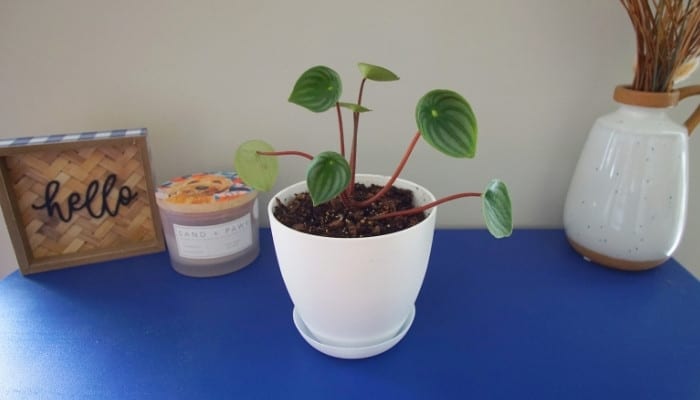
When adding any new plant to your collection, it is important to keep the plant in quarantine, away from your other plants, for at least two weeks.
This will allow any issues, such as disease or pests, to become apparent and may save your existing plants from becoming infected.
Check your new watermelon Peperomia daily for any signs of issues.
If you purchased your watermelon Peperomia as a cutting or in a nursery pot, you might want to consider transplanting or repotting it.
Additionally, a subpar soil mixture should be replaced.
Only change the soil or repot if necessary because too many changes for a plant in a short period of time can cause stress.
Ideal Soil for Watermelon Peperomia
Watermelon Peperomia will do best when planted in a well-draining, peat-based soil. A good mixture is two parts peat with one part perlite, but other combinations can work as well.
In order to maintain aeration and promote adequate drainage, it is best to include pumice, orchid bark, or perlite in your soil mixture.
Watermelon Peperomia Water Requirements
While watermelon Peperomia is a fairly easy-going plant, it can be particular when it comes to watering.
This plant is susceptible to both overwatering and underwatering. Overwatering can cause root rot and underwatering can cause wilting and drooping leaves.
Most of the year, watermelon Peperomia requires a moderate amount of water that is allowed to drain fully from the soil.
However, in the winter, growth slows, so less water is required by the plant.
Watermelon Peperomia Lighting Needs
Like many houseplants, Peperomia ‘Watermelon’ will do best in bright, indirect sunlight.
This means that it should be placed near a window, but it should not receive any direct sunlight throughout the day.
This is similar to the filtered light that would come through the canopy in its native rain forest.
While watermelon Peperomia can survive with artificial light, a west- or east-facing window is the preferred light source.
Depending on your geographic location, a south-facing window could also work.
If your watermelon Peperomia is receiving too much light during the day, the colors on the leaves and the striping will start to fade.
If the plant is receiving too little light, the leaves will become a darker green.
Ideal Temperature Range for Watermelon Peperomia
This is a tropical plant that enjoys temperatures between 65 and 75℉ (18-24℃). Never allow your watermelon peperomia to drop below 50℉ (10℃).
Ideal Humidity Level for Watermelon Peperomia
Watermelon Peperomia does best in average humidity. It will not need additional humidity in most homes.
If you live in a drier climate, periodic misting can help keep an appropriate humidity level.
During the hot summer or dry winter, additional actions may need to be taken to maintain average humidity for your watermelon Peperomia.
If the edges of the leaves are starting to brown, that is a good indicator that more humidity is needed. Some options for increasing ambient humidity include:
- Keeping many houseplants near each other.
- Misting periodically.
- Placing a pebble tray with water under the plant.
- Running a humidifier.
Best Location for Watermelon Peperomia
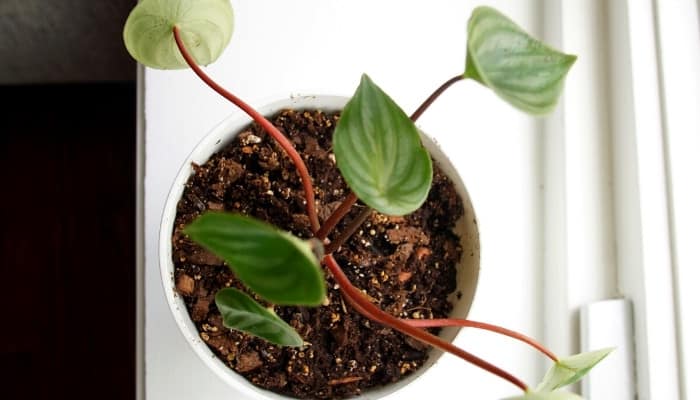
As long as it is not receiving direct sunlight, a watermelon peperomia can be placed almost anywhere in a room.
However, to achieve the healthiest and most beautiful plant, it should be placed in bright, indirect light near a window.
Watermelon Peperomia Growth Habits
This is a slow-growing plant, and during the winter, growth almost completely stops.
Watermelon Peperomia can grow up to 12 inches tall. New leaves usually come up from the center of the plant.
Fertilization Type & Schedule for Watermelon Peperomia
Watermelon Peperomia does well on a liquid fertilizer that has been diluted to half strength. Choose a fertilizer that is formulated for house plants.
Add fertilizer every 2-4 weeks during the spring and summer. Do not fertilize in winter when the plant is not growing.
Signs of Nutrient Deficiency
If your watermelon Peperomia is suffering from nutrient deficiencies, the lower leaves will start to lose their color and turn yellow from a lack of chlorophyll.
Once these leaves have lost their color, it will not return. They should be pruned to retain the health and beauty of the plant.
Once you realize your plant has a nutrient deficiency, do not over-fertilize in response.
Just fertilize with the usual half dilution of liquid houseplant fertilizer, and repeat every two weeks until the plant is back to its normal health.
Pruning Watermelon Peperomia
Regular pruning is not necessary to maintain the shape or health of watermelon peperomia.
You only need to remove dead or dying leaves to prevent the plant from wasting energy.
Does Watermelon Peperomia Produce Flowers?
Yes, watermelon peperomia produces flowers. They are small, green flowers on red or green flower spikes.
They are not showy flowers and most people only buy this plant for the foliage.
Is Watermelon Peperomia Toxic?
No, watermelon peperomia is nontoxic to pets and humans. All peperomia species are nontoxic.
Watermelon Peperomia Propagation
The most common way to propagate watermelon Peperomia is with a stem cutting. This can be cultivated in soil or water.
It is also possible to propagate watermelon peperomia using a leaf cutting.
Stem Cutting Propagation
1. Cut Off Leaves With Stems
Choose which leaves you would like to remove for propagation. Cut these stems near the base using sterilized scissors or garden shears.
2. Trim Stem to 1 Inch
Using sterilized scissors or garden shears, trim the stem on your cutting to 1 inch in length.
3. Dip Stem in Rooting Hormone
Dip the cut end of the stem into rooting hormone to help promote root growth. Skip this step if you are propagating your stem cutting in water.
4. Place Cutting Into Soil or Water
Place your cutting into moist soil or water.
If you are propagating in soil, place a plastic bag over the pot to maintain humidity and keep the soil moist. You want to replicate greenhouse conditions.
5. Place Cutting In Bright, Indirect Light
Place your cutting near a window in bright, indirect light. It can take 4-6 weeks for new roots to form and up to 6 months for new leaves to grow.
Leaf Cutting Propagation
1. Cut leaf from main plant.
2. Cut leaf in half.
3. Place cut ends of leaf halves into soil.
4. Baby plants will grow within 6 weeks.
5. Transplant baby plants to new pots.
Repotting Watermelon Peperomia
Watermelon Peperomia is a plant that prefers to be pot-bound and does not need to be repotted frequently.
Approximately every 3 years, you should transfer your plant to a new pot. In between repotting, the topsoil can be replaced annually.
When To Repot Watermelon Peperomia
It is time to repot when your watermelon Peperomia has slowed or stopped growing. You may also notice that your soil is no longer holding moisture well.
When repotting, choose a new pot that is not much larger than the previous one. This will prevent the soil from holding more water than the plant needs.
Repot your plant in the spring so that roots can grow during the summer.
Signs That It’s Time To Repot
- It’s been more than 3 years.
- Soil is no longer holding enough moisture.
- Plant has stopped growing, especially in spring and summer.
How To Repot Watermelon Peperomia
1. Choose Your New Pot
It is important to choose a new pot that is not much larger than your previous pot. Too much of a change can shock the watermelon Peperomia.
Additionally, too much soil can hold more moisture than the plant needs between waterings.
2. Remove Plant From Old Pot
Carefully remove your watermelon Peperomia from its old pot. It is likely that the roots will stretch all the way to the edge of the pot.
Loosen the roots gently and remove packed soil.
3. Place a Small Amount of Soil in the New Pot
Place 1-2 inches of soil in the bottom of the new pot (depending on the size). Keep the soil loose and do not pack it down.
4. Place Watermelon Peperomia in the New Pot
Place your plant in the new pot and gently place soil around the roots. You can shake the pot to help the soil settle between the roots.
You want to maintain aeration and drainage around the roots, so do not pack the soil down too hard.
5. Water Well
Water your plant thoroughly and allow the soil to completely drain before placing the plant back in its location.
New soil holds moisture better than old soil, so you will not need to water as frequently after repotting.
Watermelon Peperomia Common Problems and Solutions That Work
Watermelon Peperomia Common Pests
Watermelon Peperomia can be affected by any household pest. The most common pests that affect this plant are fungus gnats, mealybugs, and scales.
Fungus Gnats
Fungus gnats are small, black flies that can be seen flitting around your houseplants. Their larvae live in the soil and feed on the plants roots.
Signs of Trouble
You will see the small, black flies around your plant. There might also be thin webbing, similar to a spider web, on the surface of the soil.
Solution
Fungus gnat larvae require moist soil to survive, so minimize watering amounts, and allow soil to dry between waterings.
Sticky traps (I’ve used these traps with great success) can be placed around the plant to collect adult flies and insecticide can be applied to the soil to kill off eggs and larvae.
Prevention
Since fungus gnats require moist soil for eggs to hatch and larvae to survive, do not overwater your plant or allow the soil to stay moist.
It is also important to avoid algae growth on the pot or soil.
Some people find success using dissolved mosquito prevention pellets (used for outdoor ponds) when they water their plants.
This product works as a larvicide to kill the fungus gnat larvae.
Mealybugs
Mealybugs are one of the worst enemies for a houseplant owner. They look like white, cottony clouds and suck the sap from plants.
Signs of Trouble
White, fluffy mealybugs will be seen near the base of leaves and on new growth. Honeydew (their secretion) and black sooty mold can also be seen on the plant.
The plant itself may have stunted growth from the lack of nutrients.
Solution
A gentle shower will remove most of the mealybugs from the plant.
Follow the shower with an insecticide treatment (these granules are easy to use) applied every couple days for two weeks.
This will ensure that all eggs and larvae have been killed. You can also use alcohol on a cotton swab to kill larger adults.
Prevention
For many houseplant pests, including mealybugs, it is important to avoid overwatering and over-fertilizing your plants.
Additionally, quarantine any infested plants until you are sure that all mealybugs have been moved, as they can transfer to other plants quite easily.
Scale
Scales are similar to mealybugs, except they have a hard exterior. Once they find a location on the plant to feed, they do not move around anymore.
Signs of Trouble
Round, brown insects can be seen on any part of the plant. The plant may have stunted growth or even begin to die.
Solution
Insecticide treatment (see product recommended above) should be applied every couple of days for two weeks, ensuring that all adults and eggs have been killed off.
Prevention
Assess your watermelon Peperomia regularly for infestations, and take care not to overwater your plant.
Watermelon Peperomia Common Diseases
The most common diseases that affect watermelon Peperomia are fungal infections, but it is possible for them to be affected by viral and bacterial infections as well.
Most infections can be prevented by following an appropriate watering schedule and allowing the soil to dry between waterings.
Cercospora Leaf Spot
Signs of Trouble
Tan to black raised spots can be seen on the underside of leaves. These lesions are irregular in shape and appear to be swollen.
Solution
Spray infected leaves with a fungicide solution (this one lasts up to 30 days) until the problem is resolved.
Prevention
Do not keep your watermelon Peperomia in an overly humid environment, and avoid overwatering.
Phyllosticta Leaf Spot
Signs of Trouble
Dark brown to black spots can be seen on any part of the plant. These spots will be dry and have rings of alternating light and dark tissues.
Solution
Remove all infected leaves, and treat the rest of the plant with a fungicide (see above).
Prevention
Do not mist your watermelon Peperomia if it is prone to leaf spot. Keep any infected plants away from other plants until the infection is resolved.
Stem and Root Rot
Signs of Trouble
A plant infected with stem and/or root rot will begin to wither and drop its leaves, the plant will stop growing, and the roots will turn black and will be visibly rotten.
The base of the stem will turn mushy, and usually brown or black lesions can be seen.
Solution
Once the infection has progressed, it is unlikely that the plant will survive.
If it is possible to remove the infected section, transfer the remaining plant to a new pot and use pasteurized soil.
Prevention
If stem and root rot is common among your plants, always use new pots and pasteurized soil for new watermelon Peperomia.
Discard any infected plants, and disinfect all pots after use.
Other Common Problems
The most common problems for watermelon Peperomia are centered around watering. It is important not to overwater or underwater the plant.
Overwatering
Signs of Trouble
Yellowing leaves is the most obvious sign that your watermelon peperomia is getting too much water.
The soil will also remain wet constantly and could begin to grow algae.
Solution
Make sure the watermelon Peperomia isn’t sitting in a saucer full of water. Allow the top half of the soil to dry out before the next watering.
Once you water, allow the plant to fully drain, and discard any water that remains in the saucer.
Prevention
One technique for preventing overwatering is bottom watering. Keep your watermelon Peperomia in a nursery pot (placed inside a decorative pot with a saucer).
When it is time to water, place the nursery pot into a couple inches of water, and allow it to soak for 10 minutes.
Allow the soil to drain completely and return the nursery pot to the decorative pot.
Underwatering
Signs of Trouble
The soil will become bone dry and hard. The plant will start to go limp and have drooping leaves.
Solution
Bottom soak your plant for up to 45 minutes, allowing the soil to absorb what it needs.
Feel the top of the soil to make sure that the water has permeated the entire pot. Allow the soil to completely drain.
Prevention
Check your watermelon Peperomia’s soil frequently to determine how often it needs to be watered. Water when only the first couple inches of soil are dry.
Watermelon Peperomia Common Questions
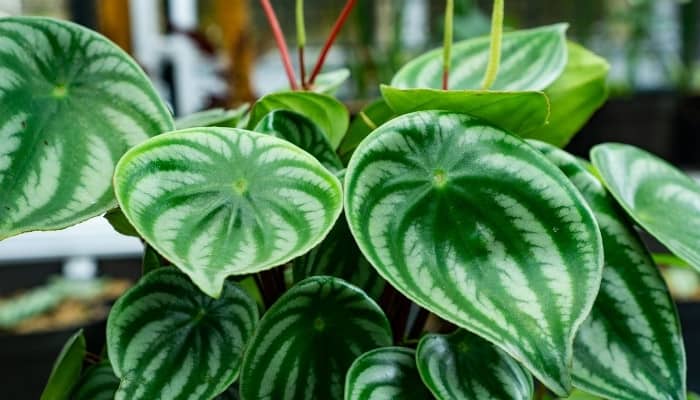
Is Watermelon Peperomia High Maintenance?
Watermelon Peperomia is an easy plant and great for beginners.
The only things to look out for are maintaining an appropriate watering schedule and being sure to keep it out of direct sunlight.
How Do You Make Watermelon Peperomia Bushy?
Move your plant to a brighter location or one that receives more hours of light during the day. Once bushier growth has begun, you can trim off older, leggy leaves.
Why Is My Watermelon Peperomia Drooping?
Drooping leaves are most likely caused by overwatering or underwatering. However, you should always check for pests when your plant is not looking healthy.
Why Is My Watermelon Peperomia Dropping Leaves?
Your watermelon Peperomia will drop leaves when it is stressed. Your plant could be stressed due to under or overwatering, pests, disease, or inadequate light.
Assess your care to determine the best course of action.
How Long Does It Take To Propagate Watermelon Peperomia?
You can expect roots to form in 4-6 weeks after beginning propagation.
Do Peperomias Like To Be Misted?
In a dry environment or during the hot summer months, your plant will enjoy an occasional misting.
However, too much moisture on the leaves can lead to fungal infections and may attract pests.
Why Is My Watermelon Peperomia Leggy?
If your Peperomia ‘Watermelon’ is not receiving enough light, its leaves will grow long stalks to find the light, causing the plant to look leggy.
Does Watermelon Peperomia Like To Be Dry?
No, your watermelon Peperomia does not like to dry out completely. Ideally, the top half of the soil will be allowed to dry before watering.
Why Are The Leaves of My Watermelon Peperomia Curling?
The most likely cause of curling leaves is overwatering, which can cause damage to the roots and water and nutrients cannot be transported up to the leaves.
How Do You Add Calcium To Watermelon Peperomia?
The easiest way to add calcium to your soil is by adding lime. If you create your own compost at home, crushed eggshells can also add calcium.
Why Does My Watermelon Peperomia Have Brown Spots?
- Too much or too little water
- Pests
- Leaf spot
- Environmental stress
Are There Different Types of Watermelon Peperomia?
No, Peperomia argyreia is the only watermelon peperomia, though it used to be known as Peperomia sandersii.
Peperomia verschaffeltii is a similar plant that is commonly called the miniature watermelon Peperomia.
Is Peperomia Frost the Same as Peperomia Watermelon?
Peperomia ‘Frost’ is a different species than Peperomia ‘Watermelon’.
3 Key Tips for Success With Watermelon Peperomia
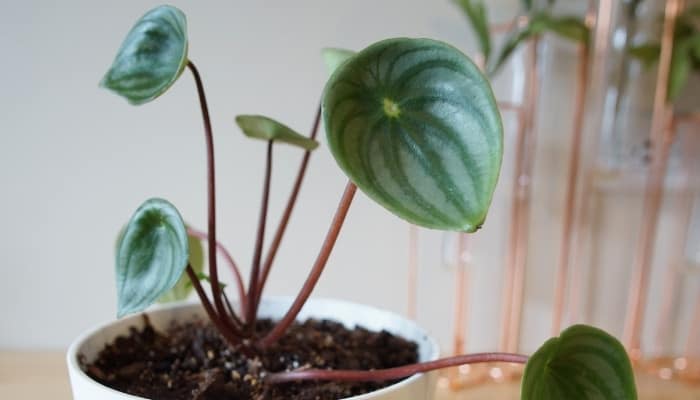
1. Find the Appropriate Amount of Water
Every plant will have different water needs based on environment and location. Your plant will do best once you determine the best amount of time between waterings.
2. Keep It Near a Window
Watermelon Peperomia looks best with lots of leaves tightly packed together.
In order to achieve this growth pattern, keep your plant close to a window with lots of bright light (but no direct sunlight).
3. Check Frequently for Pests or Disease
The best way to treat any issues is to find them early, so check your plant frequently.
Conclusion
Watermelon Peperomia is an easy-to-care-for plant that will add some interest to any room in your home.
The beautiful shimmer in the stripes of the leaves make this plant a beautiful addition.
Thanks to its easy-going nature, this plant is perfect for any houseplant lover, whether you have experience or are just beginning your collection.
